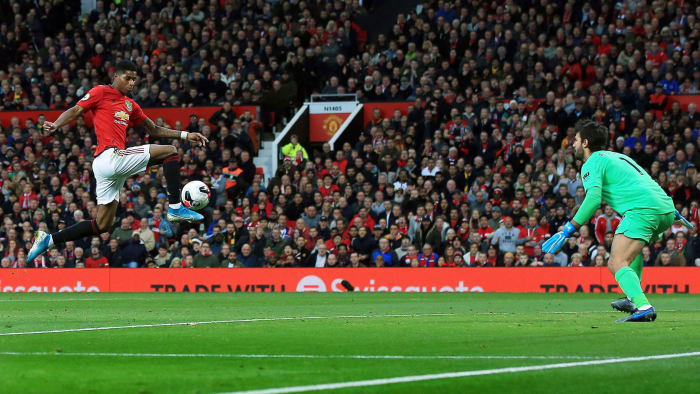Liverpool Rescues Point Against Man United in Fiery, Imperfect Matchup
Silence fell over Old Trafford. Manchester United had been six minutes from its best result since the win away to Paris Saint-Germain in March, had dreamed of beating its greatest rival and perhaps injecting the doubts that might derail its title challenge. But as Andy Robertson’s cross scudded across goal, it went through the legs of Victor Lindelof at the near post, past a host of unsighted players and came to the substitute Adam Lallana six yards out. He couldn’t miss and didn’t miss: he had his first goal since May 2017 and Liverpool had salvaged a point.
It was an outcome that had seemed improbable for much of the game. The result may not have been quite what United hoped it might with Marcus Rashford’s 36th-minute goal, but this was still its best performance since the opening-day win over Chelsea. One game doesn’t suddenly validate Ole Gunnar Solskjaer’s reign at United or put right the structural issues that have dogged the club since Sir Alex Ferguson retired in 2013, but it does at least buy him time and point towards a brighter future.
Liverpool’s run of consecutive Premier League victories was ended on 17, one fewer than Manchester City’s record. It remains six points clear of City at the top of the table (with United 13th, nine points further back) but there must be concerns about how disjointed it looked, how its passing was poor both in conception and execution.
Perhaps it was simply the Old Trafford factor (Liverpool has beaten its great rival away only once in its last 14 visits) or, more troublingly, it may be that Solskjaer’s switch to a back three has shown others a way this Liverpool can be thwarted.
This was, it should be said, a Liverpool with Mohamed Salah, the victim of an ankle injury, which meant a berth for Divock Origi, the only player who had also started Jurgen Klopp’s first game in charge, four years ago this weekend. And it should also be said that the United goal was highly controversial.

Man United striker Marcus Rashford scores the opener past Liverpool goalkeeper Alisson at Old Trafford
Origi was, fairly obviously, fouled by Victor Lindelof, who challenged him from behind and kicked him on the calf. Scott McTominay picked up the loose ball, United burst down the right through Daniel James. He crossed and Marcus Rashford, having pulled cleverly away from Joel Matip, knocked the ball past Allison from eight yards. VAR checked the incident and declined to overturn the decision of the on-field official. That was consistent with how VAR has been used in the Premier League this season, but it again raised the question that if an offense that clear is not overturned, what is the point of the system?
VAR’s problematic implementation was further exposed two minutes before half time as Sadio Mane had a goal ruled out for a handball as he took down a long ball. It probably was handball, and certainly contravened the new regulation that any touch on the hand in the build-up to a goal is to be penalized, but the more fundamental question remained: why is their strict liability for the ball touching an arm but not for one player kicking another?
But beyond such technicalities, there was a clear sense that United at half time had been the better side. Solskjaer had adopted a back three, which allowed the wing-backs, Aaron Wan-Bissaka and Ashley Young, to engage Liverpool’s marauding full-backs high up the pitch, restricting their effectiveness. But he also played Rashford and James as split strikers with Andreas Pereira as a false nine behind them.
That caused repeated problems and had Pereira’s passing been as good as the rest of his play, United might have been further ahead by the break.
Liverpool switched shape in the second half to a 4-2-3-1 and then a 4-4-2, which promoted Solskjaer to counter by pulling Pereira deeper into a more orthodox 3-5-2. Gradually balance of play tipped Liverpool’s way, although without the sort of barrage of chances it is capable of producing at its best.
In the end, the equalizer came and Liverpool can take heart from the way, on a poor day, it kept battling and took a point from a fixture it often finds troublesome.
United will think of what might have been, perhaps what should have been, but this was still its most encouraging performance from some time. And so, from a largely ugly, patchy game, both sides can draw positives.





